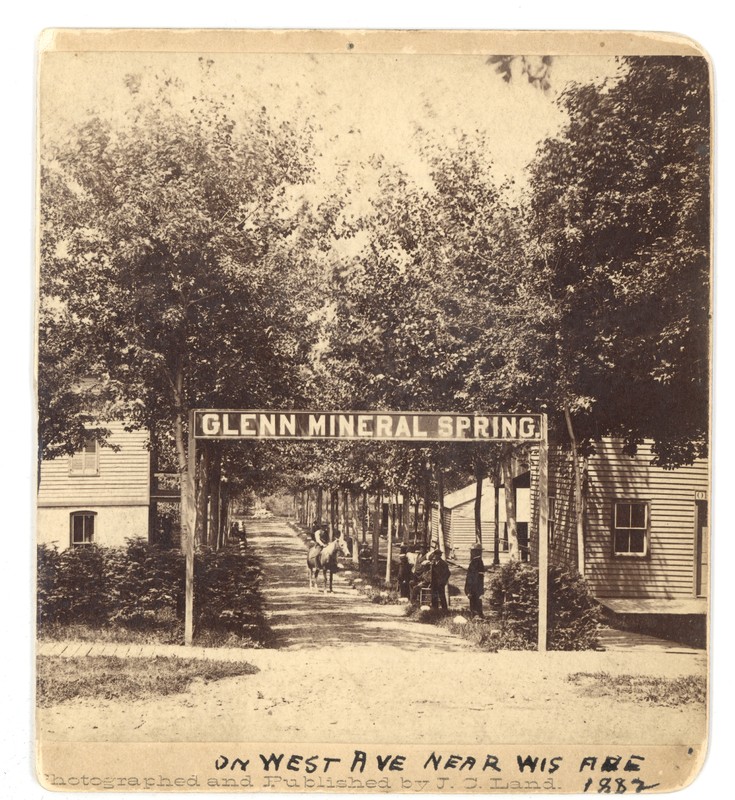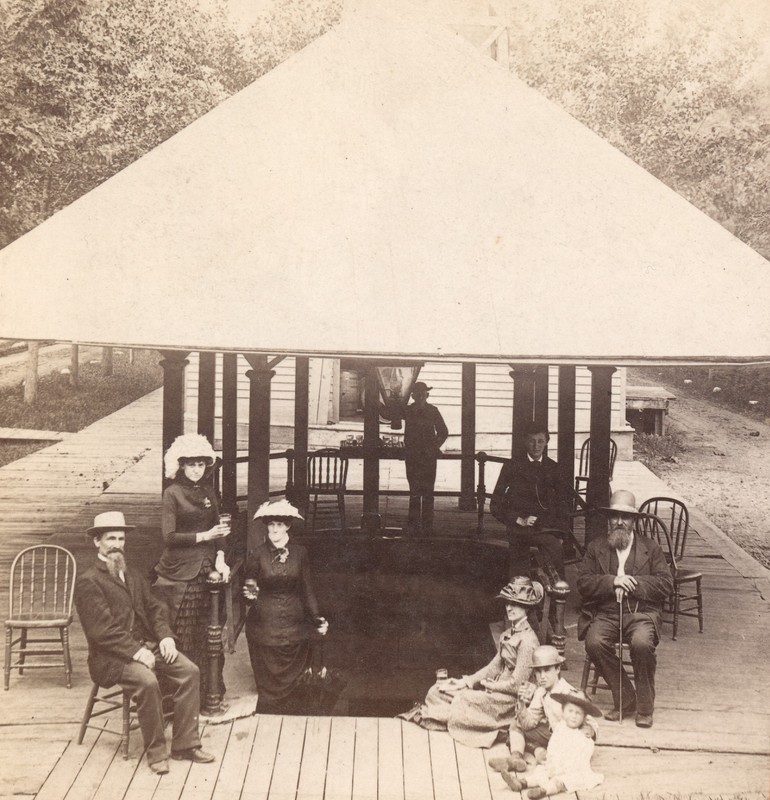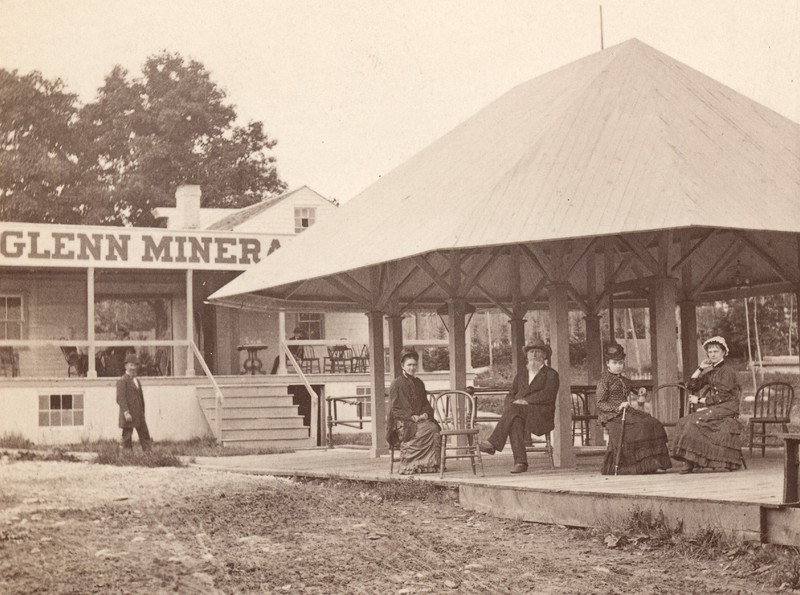Glenn Spring
Introduction
Text-to-speech Audio
Glenn Spring was located on West Ave. next to Henk and Hygeia springs. Opened in 1875 by New York businessman J.K. Glenn, this little spring caused several controversies in Waukesha. The first was J.K. Glen's claim that his spring was the true source of the larger and more profitable Bethesda Spring.
The second was during the early 1890's when the spring became part of the Great Pipeline Battle, to directly pump Waukesha spring water to the Chicago Colombian Exposition. The spring was purchased by James E. McElroy with the hope of pumping water from Hygiea Spring to Chicago for the World’s Colombian Exposition of 1893. The plan ultimately failed and the spring was sold, along with Hygeia Spring, to J.K. Anderson who incorporated the new Waukesha Water Company. Anderson opened the spring grounds for free to the community. The site remained through the end of the 1920's but was developed for residential homes after 1929. Today an alleyway, Glenwood Drive is a small reminder of the former Glenn Spring site.
Images
The entrance to Glenn spring as seen in 1882

Detail of stereoview showing Glenn Spring

Relaxing at Glenn Spring

Backstory and Context
Text-to-speech Audio
During the late 19th and early 20th century Waukesha became a wellness-destination for tourists. Hydropathy - or water cure - treatments had become rigor de jour in both the United States and Europe during the Victorian Era as an alternative to the interventions of traditional medical care. Wisconin's mild summer climate was especially attractive to tourists from Texas, Louisianna, and Mississippi.
James K. Glenn, a New York millionaire, came to Waukesha in 1875 in search of a cure for his diabetes. Like countless others, Glenn relaxed and drank Waukesha's waters, and after a week he proclaimed himself cured. Inspired, Glenn wanted to join in the spring water business. He consulted Col. Richard Dunbar, a fellow New Yorker, and owner of the famed Bethesda Spring. At first Glenn proposed a business deal to become an agent selling Bethesda spring water in New York, but this deal never came to be.
The Waukesha Freeman newspaper reported on October 7th, 1875 that a new spring had been "discovered" on West Ave. This spring was not in fact a proper natural spring where the water flows to the surface from a vein of groundwater, but a dug well. Glenn had purchased part of the property and dug the land down, so that it looked like a natural spring, surrounding it in limestone block. This spring was under a pavilion and was located behind a large office building with a sign “GLENN WAUKESHA MINERAL SPRING”. At the back of the building, there was a porch where guests could sit which later was enlarged to a small bath house. The property was surrounded by a white picket fence and included a second pavilion, which eventually became the location of the bottling plant, as well as a long driveway with boardwalk on each side and trees that eventually grew up create a canopy to shade the visitors. People could also access the park by renting a boat on the Fox River.
Within a few months from its initial purchase, everything was going well for the so-called Glenn Spring and it gained popularity. Trouble began in 1876 when Glenn started advertising the water bottled from his spring as Glenn-Bethesda. He claimed that his spring was the true source of the nearby Bethesda Spring, and therefore purer than Bethesda. Colonel Dunbar, the owner of Bethesda Spring, objected to the claim and name use, filing a lawsuit against Glenn for copyright infringement.
Glenn attempted to prove that his spring was the true source of Bethesda by conducting an experiment to exhaust the flow of Bethesda spring. It is noteworthy that Glenn Spring is downhill from Bethesda Spring, therefore water would have to flow uphill for the claim that Glenn Spring was the source of Bethesda Spring to be true. This experiment failed, but Glenn would not be stopped. He proceeded to publish untrue and harmful claims about Bethesda Spring and Col. Dunbar in local newspapers. The people of Waukesha began to get angry with Glenn. Multiple additional tests were carried out to figure out once and for all if Glenn Spring was truly the source of Bethesda, and all of these tests proved that it was not. Finally, in an 1877 decision by the Wisconsin Supreme Court it was decided that Bethesda was not Glenn's rightful trademark.
Things eventually settled down and Glenn began to make up for what he had done, improving his standing in the Waukesha community. Glenn hired a businessman, Mr. N. H. Glenny, to manage the spring and Glenn visited the spring often during the summer months up until his death in February 1882. At the time of his death, James Glenn was fondly remembered by the Waukesha community, despite the earlier water fiasco. Glenn Spring was sold to new owners by J. K. Glenn’s window, Mary, their daughter, Cordie, and her husband, George.
In 1883, Theodore H. Bryant of Chicago purchased the Glenn Spring for $30,000 and talked about improving the property. It ended up being only talk and after going into foreclosure in 1887, Theodore sold it to Charles Browne of Colorado for $40,000. This sale was voided by lawsuits. Mary Glenn purchased the spring again for $28,000 on May 20, 1887, allowing the bottling of Glenn Spring water to continue. Glenny was noted as the manager there in 1888. In July of 1891, Mary sold the Glenn Springs property to Roland R. Conklin for $15,000.
Prior to the 1893 Chicago Columbian World Exposition, James E. McCley purchased the Glenn Spring from Conklin with the intention of pumping water from a combined Glenn-Hygiea Spring reservoir through a pipeline to Chicago. There he would sell 'fresh' Waukeha Spring Water to the millions of projected attendees at the Exposition. However, residents stopped the pipeline and in the end Glenn Spring was sold with Hygiea Spring to J. K. Anderson.
Anderson incorporated Glenn and Hygeia springs into the Waukesha Water Company. The public was admitted for free to the Hygeia-Glenn spring, making it a popular attraction. After six years, it fell into receivership and in 1900 a fire occurred in the Glenn Spring bottling plant.
Maps show that the spring was in existence until at least 1929, but shortly after the land was developed for homes. A reminder of the spring today comes in the form of a small alley named Glenwood Drive that leads from West Avenue to the Fox River. This alley follows the former entrance to Glenn Spring.
Sources
Schoenknecht, John M. Glenn Spring: Queen of Waters. Landmark Magazine. Spring 1993, 1-11.
Schoenknecht, John Martin. The Great Waukesha Springs Era 1868-1918. Waukesha, Wisconsin. 2003.
Schoenknecht, John M. William H. Anderson, James K. Anderson, and Waukesha’s Springs. Landmark Magazine. Spring 1994, 2-15.
Spring City's Past, Waukesha Landmarks Commission, January 2002.
Waukesha County Democrat, Waukesha Wisconsin, Saturday, October 9, 1875, p.3.
Waukesha Freeman, Waukesha Wisconsin, October 7th, 1875
Waukesha County Historical Society & Museum Photography Collections
Waukesha County Historical Society & Museum Photography Collections
Waukesha County Historical Society & Museum Photography Collections
